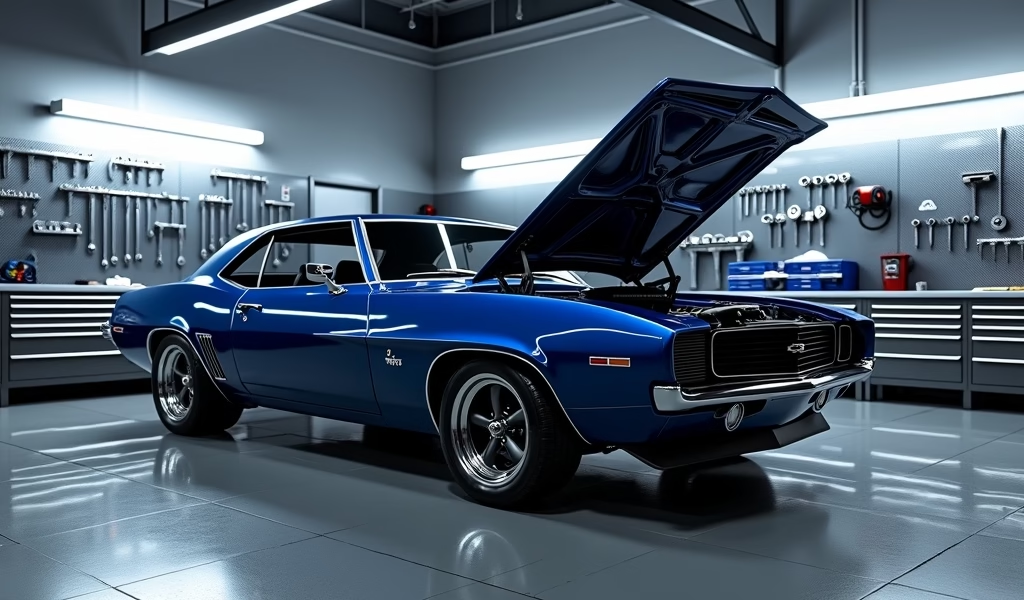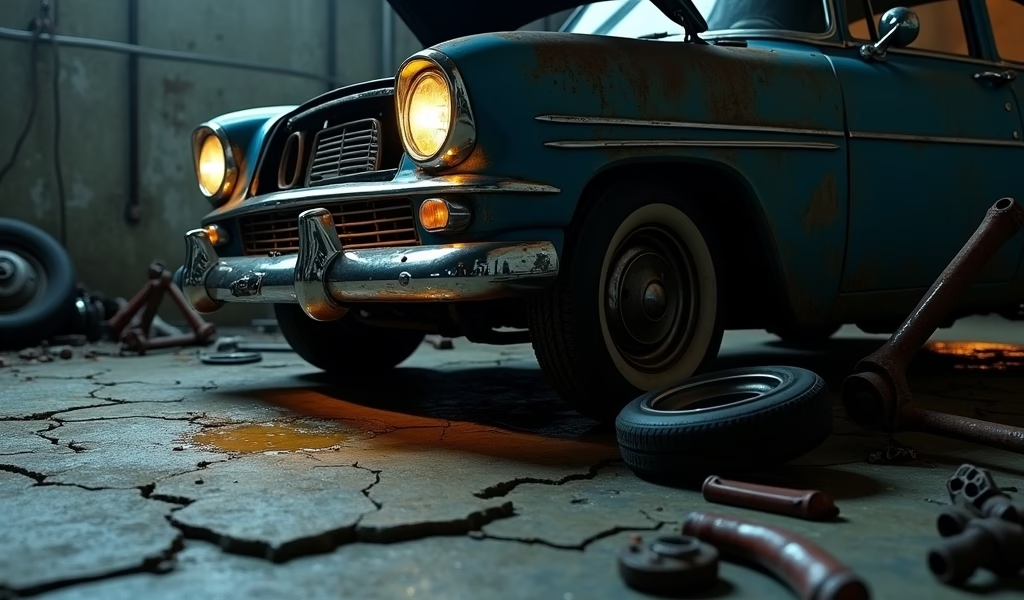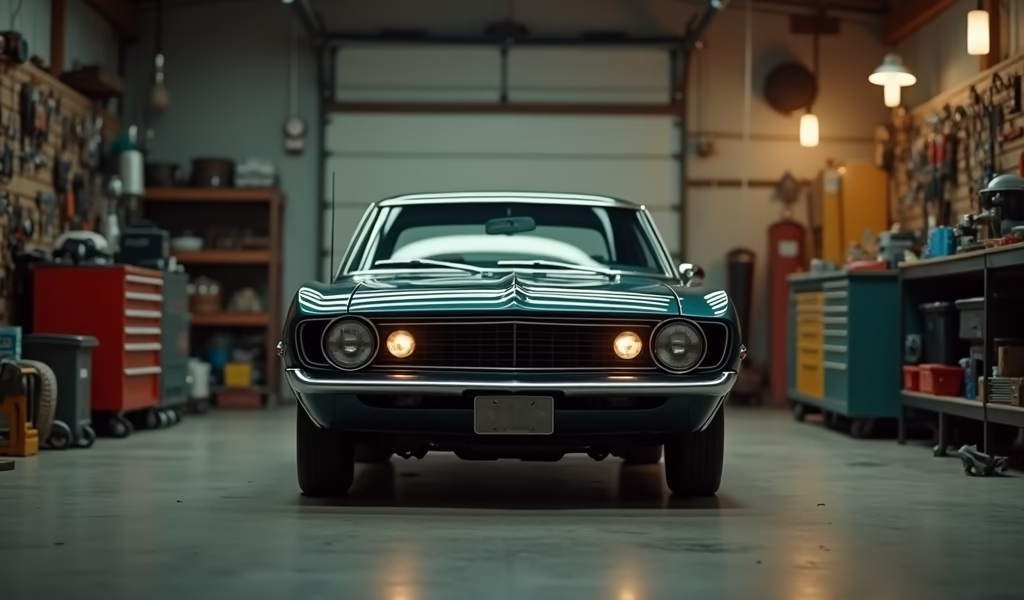Overview
This guide provides detailed maintenance advice for owners of iconic movie cars, covering essential tools, maintenance schedules, and specific care instructions for vehicles like the DeLorean DMC-12, Bullitt Mustang, and Aston Martin DB5. It emphasizes both mechanical upkeep and preservation of authentic appearance, while connecting enthusiasts with community resources and professional support for these rolling pieces of cinema history.
Table of Contents
- Iconic Movie Cars That Stole the Show
- Essential DIY Tools for Movie Car Maintenance
- Maintenance Schedule for Your Cinematic Ride
- Engine Care for Different Movie Car Types
- Body and Paint: Keeping the Silver Screen Shine
- Interior Care: Preserving Movie Magic Inside
- Common Problems and Quick Fixes
- Community Resources for Movie Car Enthusiasts
- Conclusion
- Frequently Asked Questions
The rumble of a powerful engine, the gleam of polished chrome, and the unmistakable silhouette that makes your heart race—there’s something magical about iconic movie cars that captures our imagination long after the credits roll. As both a mechanic and film enthusiast, I’ve spent decades helping collectors maintain these rolling pieces of cinema history. Whether you’re the proud owner of a DeLorean replica or simply dream of caring for McQueen’s Mustang someday, this guide will show you how to keep these mechanical celebrities running in their prime.
Movie cars aren’t just vehicles; they’re characters with personalities as memorable as the heroes who drove them. From the menacing rumble of Dominic Toretto’s Charger to the sophisticated purr of James Bond’s Aston Martin, these machines demand specialized care that honors their on-screen legacy while ensuring they remain roadworthy for years to come.
The good news? With the right knowledge and tools, you can handle much of this specialized maintenance yourself. Let’s pop the hood and explore how to keep your slice of cinema history purring like it did on the silver screen.
Iconic Movie Cars That Stole the Show
Before diving into maintenance specifics, let’s celebrate the four-wheeled stars that have earned their place in film history. These aren’t just cars—they’re automotive characters with as much personality as their human co-stars.
The DeLorean DMC-12 from “Back to the Future” transformed a troubled production car into a time-traveling icon. With its stainless steel body and gull-wing doors, this vehicle presents unique challenges from its temperamental PRV V6 engine to its finicky electrical system.
Steve McQueen’s 1968 Ford Mustang GT from “Bullitt” defined the movie car chase. That Highland Green fastback with its rumbling 390 cubic inch V8 requires careful carburetor tuning and suspension maintenance to maintain its legendary handling capabilities.
The 1970 Dodge Charger from “The Fast and the Furious” showcases raw American muscle. Dominic Toretto’s menacing black beast with its massive supercharger demands specialized care for both its stock components and aftermarket modifications.
The Aston Martin DB5 from the James Bond franchise combines British elegance with spy-worthy performance. Its aluminum body and complex inline-six engine require a gentlemanly touch during maintenance.
The 1959 Cadillac Ecto-1 from “Ghostbusters” proves that even an ambulance can become iconic. This massive vehicle demands attention to both its underlying Cadillac mechanics and custom ghost-hunting equipment.

Essential DIY Tools for Movie Car Maintenance
Like any skilled craftsman, a movie car enthusiast needs the right tools. Here’s what should be in your garage:
Basic Tool Kit Essentials
Start with quality socket sets in both metric and standard sizes. The DeLorean and European models like the Aston Martin need metric tools, while classic American muscle cars typically require standard measurements. Invest in tools made from chrome vanadium steel—cheap tools strip fasteners and cause more problems than they solve.
A quality floor jack and jack stands are non-negotiable. Never work under a vehicle supported only by a hydraulic jack—I’ve seen too many close calls in my years as a mechanic. A good set of combination wrenches, screwdrivers, and pliers rounds out the basics.
Specialty Tools Worth the Investment
- Timing light for tuning distributors in classic cars
- Carburetor synchronization tools for multi-carb setups
- Digital multimeter for electrical diagnostics
- Compression tester for engine health checks
- Model-specific tools (like stainless steel cleaning kits for DeLoreans)
For DeLorean owners specifically, invest in specialized tools for working with stainless steel and accessing components behind those unique body panels. Aston Martin enthusiasts should acquire British-specific tools, including Whitworth wrenches that fit those distinctively-sized fasteners.
Safety Equipment Recommendations
Movie cars deserve careful attention, but your safety comes first. Always keep a fire extinguisher rated for automotive fires nearby. Chemical-resistant gloves, safety glasses, and proper ventilation are essential when working with solvents or running engines indoors. NIOSH recommends specific safety protocols for automotive work that can prevent serious injuries.
Maintenance Schedule for Your Cinematic Ride
Even screen legends need regular checkups. Here’s a maintenance schedule worthy of your four-wheeled celebrity:
Weekly Checks
Take five minutes each week for a quick walk-around. Check fluid levels (oil, coolant, brake fluid), inspect tire pressure, and look for any fresh leaks under the vehicle. Start the engine and listen for unusual noises—early detection prevents most catastrophic failures.
Monthly Tasks
- Detailed undercarriage inspection
- Belt tension check
- Hose inspection for cracks or wear
- Battery terminal cleaning
- Thorough engine bay cleaning
For stainless steel DeLoreans, monthly cleaning with appropriate products prevents corrosion at panel seams. For painted beauties like the Bullitt Mustang, check for early signs of oxidation, especially in body creases where moisture collects.
Seasonal Considerations
Before summer, ensure cooling systems are thoroughly flushed and inspected—nothing kills movie magic faster than overheating in parade traffic. Before winter, check antifreeze concentration and apply appropriate undercoating to prevent salt damage if you’re driving in snowy regions.
For vehicles with convertible tops like the Ferris Bueller Ferrari replica, apply UV protection before summer sun exposure and waterproofing treatments before wet weather seasons.
Annual Deep Maintenance
Schedule a weekend each year for comprehensive service. Change all fluids (engine oil, transmission, differential, brake fluid), inspect or replace spark plugs, check distributor cap and rotor (for classic ignition systems), and lubricate suspension components.
For carbureted engines common in muscle cars, an annual rebuild or cleaning ensures proper fuel delivery and prevents the varnish buildup that plagues vehicles driven infrequently. This annual ritual keeps your movie car running properly and gives you intimate knowledge of its condition.
Engine Care for Different Movie Car Types
The heart of any vehicle is its engine, and movie cars are no exception. Each iconic model has specific needs:
The DeLorean’s Temperamental PRV V6
This Franco-Italian powerplant needs special attention to its cooling system—these engines run notoriously hot. Regular valve adjustments are crucial, as is careful maintenance of the K-Jetronic fuel injection system. Consider upgrading to a higher-capacity radiator and modern electronic ignition for improved reliability.
Pay particular attention to the timing belt—when these fail, catastrophic engine damage follows. Replace it every 30,000 miles regardless of apparent condition, and you’ll avoid the heartbreak of a seized engine.
American V8 Muscle
The Mustangs and Chargers of movie fame thrive with regular carburetor adjustments and valve lash checks. Use high-zinc oils specifically formulated for flat-tappet camshafts to prevent premature wear. Engine Labs explains why modern oils often lack the zinc content these classics need.
For modified engines with aftermarket superchargers (like Toretto’s Charger), pay careful attention to fuel delivery systems and ignition timing. These high-compression beasts demand precision tuning to prevent detonation that can destroy pistons.
British Precision (Aston Martin)
The DB5’s inline-six requires a gentleman’s touch—smooth, deliberate maintenance rather than brute force. Oil changes every 3,000 miles with proper weight oils preserve these precision machines. Careful attention to cooling systems prevents the overheating that plagues many British classics.
SU carburetors need synchronized tuning using proper vacuum gauges. The Lucas electrical components (“The Prince of Darkness”) benefit from preventative maintenance—clean all connections regularly and consider strategic upgrades that preserve appearance while improving reliability.

Body and Paint: Keeping the Silver Screen Shine
A movie car’s appearance is as important as its performance. Here’s how to keep yours looking camera-ready:
Stainless Steel Care (DeLorean)
That unpainted stainless body is the DeLorean’s calling card, but it requires specialized care. Clean with products specifically designed for stainless steel—never household cleaners. Work in the direction of the grain using microfiber cloths to prevent scratching.
Address scratches with specialized stainless polishing kits that progressively refine the surface. Store indoors whenever possible—despite its seemingly tough exterior, environmental contaminants can cause discoloration that’s difficult to remove.
Classic Paint Preservation
For painted beauties like the Highland Green Mustang or jet-black Charger, regular washing with pH-neutral automotive soap prevents contaminant buildup. Apply quality carnauba wax quarterly, working in small sections in shaded areas.
Consider modern ceramic coatings for long-term protection that preserves the original appearance while adding a layer of defense against environmental damage. For show cars, paint thickness gauges help monitor condition over time and identify areas needing attention before damage becomes visible.
Weather Protection
Garage storage is ideal, with climate control if possible. For those without climate-controlled space, use desiccants to control humidity and prevent the formation of condensation that leads to rust. Install UV-filtering film on garage windows to prevent sun damage to interiors.
For movie cars stored long-term, implement thorough rodent prevention measures—nothing ruins authentic upholstery faster than mice making homes in your seat cushions. Remember to drive your vehicle periodically; cars deteriorate faster in storage than with regular, gentle use.
Interior Care: Preserving Movie Magic Inside
The cockpit of your movie car deserves special attention to maintain its authentic appearance:
Vintage Material Preservation
Use leather conditioners specifically formulated for vintage hides—modern products can be too aggressive. Clean vinyl with appropriate products that won’t cause cracking, and vacuum regularly using attachments with soft bristles to prevent scratching delicate surfaces.
Apply UV protectants to prevent sun damage, particularly on dashboards and door panels that receive direct sunlight. For irreplaceable components showing significant wear, consider working with specialists in automotive upholstery restoration who understand period-correct materials and techniques.
Custom Features and Gadgets
From flux capacitors to ejector seat buttons, custom features need specialized care. Create a detailed inventory with photos documenting the correct appearance and function of each component. Clean electrical contacts regularly with electronic-safe contact cleaner and lubricate moving parts with appropriate products.
Test functionality periodically to identify issues before they become serious problems. For irreplaceable components, consider having backup parts fabricated while originals are still available for reference. Many family-friendly car movies inspire creative modifications that require equally creative maintenance solutions.
Balancing Authenticity and Usability
For movie cars that are driven regularly, balance originality with practical improvements. Consider hidden modern safety upgrades that don’t affect appearance—better brake systems, improved seat belts, or discreet electronic ignition conversions can make your movie car safer and more reliable without compromising its authentic look.
Document original configurations thoroughly before making changes, preserving the option to return to stock for shows or special events. The best approach preserves the spirit and appearance of the original while making sensible improvements where they don’t detract from the vehicle’s character.
Common Problems and Quick Fixes
Every star has their quirks. Here are some common issues with movie cars and how to address them:
Electrical Gremlins
Electrical problems plague many movie cars, especially those with custom additions. Create detailed wiring diagrams specific to your vehicle’s modifications. Use dielectric grease on all connections to prevent corrosion and consider upgrading to modern fuse blocks while maintaining vintage appearance.
For vintage British cars like the DB5, a full rewiring with modern materials (hidden, of course) can transform reliability without changing the car’s character. Test circuits methodically with a quality multimeter rather than randomly replacing components.
Cooling System Issues
Overheating ends many movie car outings prematurely. Flush radiators annually with proper cleaners and consider upgrading to aluminum radiators when they can be hidden from view. Use modern coolants with appropriate corrosion inhibitors that provide better protection than original formulations.
Electric fan conversions offer improved cooling at idle—crucial for parade appearances where these cars often shine. Pressure test cooling systems regularly to catch leaks early, before they strand you at a show or event.
Fuel System Challenges
Modern ethanol-blend fuels wreak havoc on vintage fuel systems. Use fuel stabilizers for vehicles driven infrequently and consider ethanol-resistant upgrades for fuel system components. Clean carburetors annually with ultrasonic cleaners for thorough removal of varnish deposits.
For fuel-injected movie cars like later DeLoreans, regular injector cleaning prevents performance issues. Always carry spare fuel filters—they’re inexpensive insurance against roadside troubles.
Community Resources for Movie Car Enthusiasts
You’re not alone in your passion for cinematic automobiles. Connect with these valuable resources:
Online Communities
Model-specific forums offer technical support from fellow owners who’ve already solved problems you might encounter. General movie car communities provide broader knowledge about maintaining authentic appearances and sourcing difficult-to-find parts.
YouTube channels dedicated to movie car restoration offer visual guidance for complex procedures. These communities aren’t just technical resources—they’re gatherings of like-minded enthusiasts who share your passion.
Specialty Parts Sources
Original manufacturer heritage programs (like Aston Martin Works) provide factory-correct components for discerning restorers. Dedicated reproduction parts manufacturers fill gaps for discontinued items, while 3D printing services can recreate impossible-to-find plastic components.
For custom movie car gadgetry, specialty electronics fabricators can reproduce or improve upon original designs. Establishing relationships with these providers before you need emergency parts makes projects run smoothly.
Professional Support
Even dedicated DIYers occasionally need specialized help. Cultivate relationships with:
- Marque specialists for manufacturer-specific guidance
- Professional restorers for complex body or upholstery work
- Specialty machine shops for fabricating one-off components
- Paint matching experts who understand vintage formulations
These professionals can provide targeted assistance for jobs beyond typical DIY capabilities, saving you time and preventing costly mistakes.
Conclusion
Maintaining a piece of cinema history combines mechanical skill with a curator’s careful touch. These iconic vehicles carried not just their on-screen drivers but millions of viewers into worlds of adventure, excitement, and imagination. Through consistent, thoughtful DIY maintenance, you preserve not just a car but the dreams and memories it represents.
Whether you’re polishing the stainless steel panels of a time-traveling DeLorean or tuning the thunderous V8 of a chase-scene Mustang, remember that your work honors both automotive and film heritage. With each oil change, wax application, or carburetor adjustment, you’re keeping a mechanical movie star ready for its next close-up.
The best movie cars weren’t built for brief fame—they were engineered to become legends. With your dedicated maintenance, these four-wheeled icons will continue telling their stories for generations to come. After all, in both movies and mechanics, the most powerful stories are the ones that stand the test of time.
Frequently Asked Questions
What’s the most replicated movie car among collectors?
The DeLorean DMC-12 from Back to the Future tops the list, with thousands of replicas ranging from simple cosmetic modifications to screen-accurate time machines. The car’s distinctive stainless steel body and gull-wing doors make it instantly recognizable even with minimal modifications.
How much does it cost to maintain a movie car replica annually?
Expect to spend between $1,500-$5,000 annually for routine maintenance, depending on the vehicle’s complexity and how often it’s driven. This doesn’t include major restoration work or significant parts replacement, which can easily double or triple that figure.
Can I daily-drive a movie car replica?
Most movie cars can be daily driven with appropriate reliability modifications, but doing so significantly increases maintenance requirements and wear. Consider reserving your cinematic ride for weekend pleasure drives to preserve both its condition and special-occasion feel.
What’s the best starter movie car for a new collector?
The 1968 Mustang fastback from Bullitt offers the perfect balance of recognizability, reasonable maintenance costs, and parts availability. These vehicles are robust, relatively simple to work on, and benefit from extensive aftermarket support.
Do movie car replicas appreciate in value?
Well-built, accurate replicas of iconic movie cars typically maintain or gradually appreciate in value, particularly those with documentation and screen-accurate details. However, buy them for passion rather than investment, as the market can be highly subjective.

